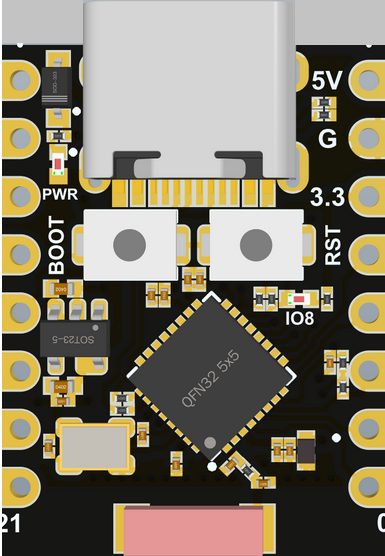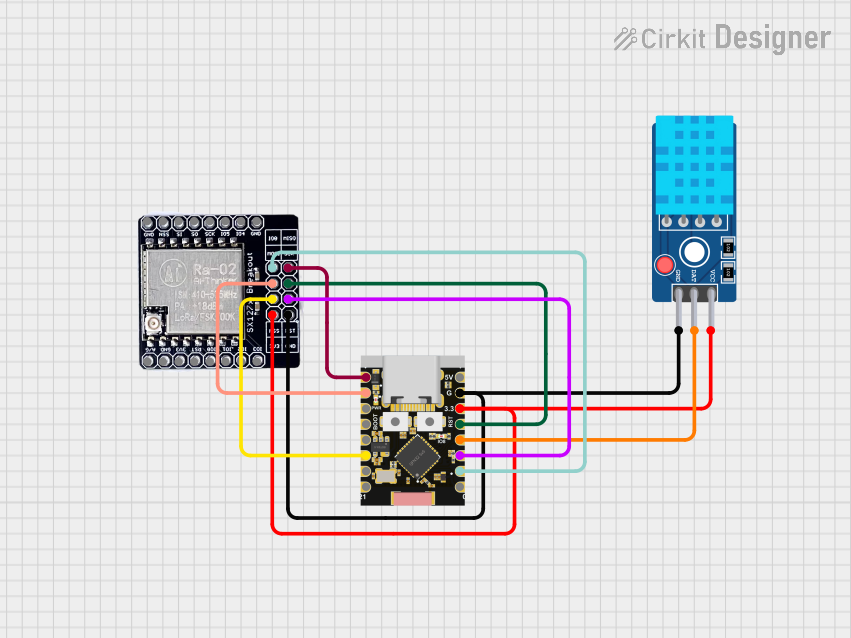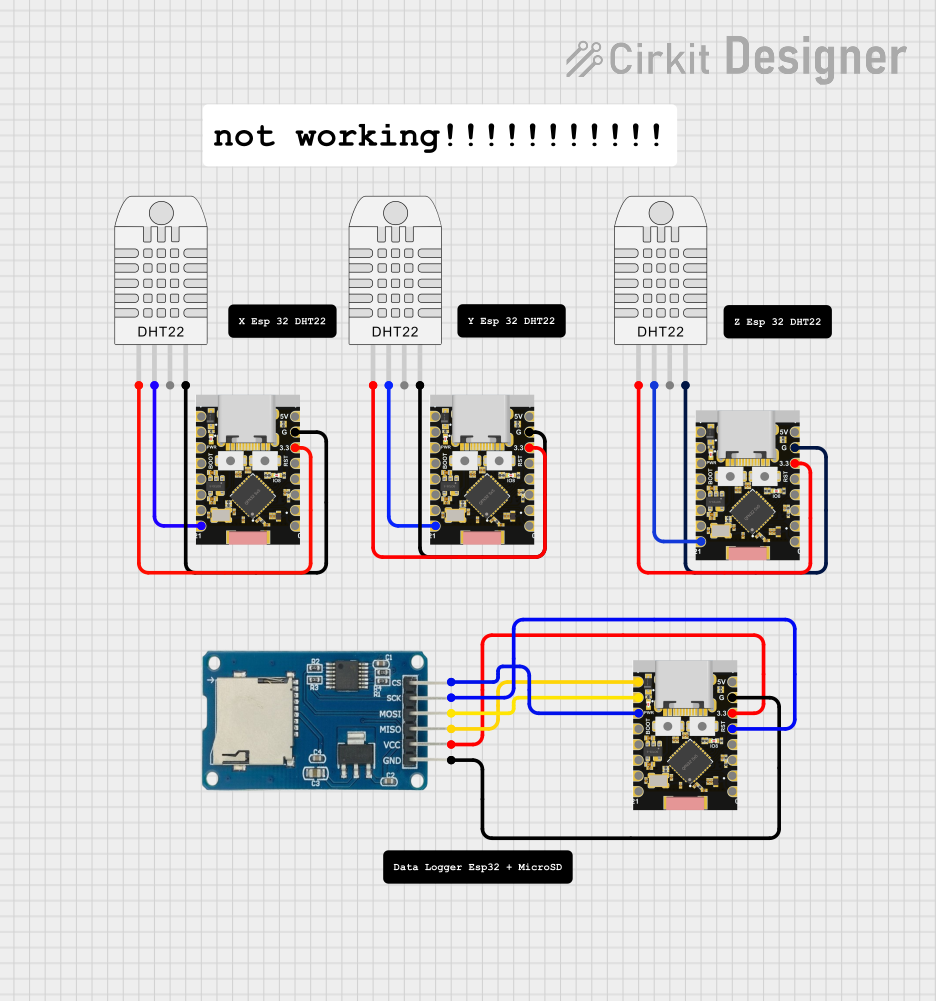
How to Use ESP32C3 Supermini: Examples, Pinouts, and Specs

 Design with ESP32C3 Supermini in Cirkit Designer
Design with ESP32C3 Supermini in Cirkit DesignerIntroduction
The ESP32C3 Supermini is a compact and powerful microcontroller module manufactured by Generic. It features integrated Wi-Fi and Bluetooth Low Energy (BLE) capabilities, making it an excellent choice for Internet of Things (IoT) applications, smart devices, and embedded systems. Its small form factor and robust performance allow it to be used in space-constrained designs while maintaining high efficiency and reliability.
Explore Projects Built with ESP32C3 Supermini

 Open Project in Cirkit Designer
Open Project in Cirkit Designer
 Open Project in Cirkit Designer
Open Project in Cirkit Designer
 Open Project in Cirkit Designer
Open Project in Cirkit Designer
 Open Project in Cirkit Designer
Open Project in Cirkit DesignerExplore Projects Built with ESP32C3 Supermini

 Open Project in Cirkit Designer
Open Project in Cirkit Designer
 Open Project in Cirkit Designer
Open Project in Cirkit Designer
 Open Project in Cirkit Designer
Open Project in Cirkit Designer
 Open Project in Cirkit Designer
Open Project in Cirkit DesignerCommon Applications and Use Cases
- IoT devices and smart home automation
- Wearable technology
- Wireless sensor networks
- Industrial automation
- Prototyping and development of connected devices
- Low-power Bluetooth applications
Technical Specifications
The following table outlines the key technical details of the ESP32C3 Supermini:
| Parameter | Value |
|---|---|
| Manufacturer | Generic |
| Part ID | ESP32C3 Supermini |
| Microcontroller Core | 32-bit RISC-V single-core processor |
| Clock Speed | Up to 160 MHz |
| Flash Memory | 4 MB (onboard) |
| SRAM | 400 KB |
| Wireless Connectivity | Wi-Fi 802.11 b/g/n (2.4 GHz), Bluetooth 5.0 Low Energy (BLE) |
| Operating Voltage | 3.3V |
| GPIO Pins | 15 (multipurpose, including ADC, PWM, I2C, SPI, UART) |
| ADC Resolution | 12-bit |
| Power Consumption | Ultra-low power in deep sleep mode (<5 µA) |
| Dimensions | 18 mm x 25 mm |
| Operating Temperature | -40°C to +85°C |
Pin Configuration and Descriptions
The ESP32C3 Supermini has a total of 15 GPIO pins, which are multifunctional and can be configured for various purposes. Below is the pinout description:
| Pin Number | Pin Name | Function | Description |
|---|---|---|---|
| 1 | GND | Ground | Connect to system ground |
| 2 | 3V3 | Power Supply | 3.3V power input |
| 3 | GPIO0 | GPIO, ADC, UART_TX | General-purpose I/O, ADC, UART TX |
| 4 | GPIO1 | GPIO, ADC, UART_RX | General-purpose I/O, ADC, UART RX |
| 5 | GPIO2 | GPIO, PWM, I2C_SDA | General-purpose I/O, PWM, I2C data line |
| 6 | GPIO3 | GPIO, PWM, I2C_SCL | General-purpose I/O, PWM, I2C clock line |
| 7 | GPIO4 | GPIO, SPI_MOSI | General-purpose I/O, SPI data out |
| 8 | GPIO5 | GPIO, SPI_MISO | General-purpose I/O, SPI data in |
| 9 | GPIO6 | GPIO, SPI_CLK | General-purpose I/O, SPI clock |
| 10 | GPIO7 | GPIO, SPI_CS | General-purpose I/O, SPI chip select |
| 11 | GPIO8 | GPIO, ADC | General-purpose I/O, ADC input |
| 12 | GPIO9 | GPIO, PWM | General-purpose I/O, PWM output |
| 13 | GPIO10 | GPIO, ADC | General-purpose I/O, ADC input |
| 14 | EN | Enable | Module enable pin |
| 15 | RST | Reset | Module reset pin |
Usage Instructions
How to Use the ESP32C3 Supermini in a Circuit
- Power Supply: Provide a stable 3.3V power supply to the
3V3pin and connect theGNDpin to the system ground. - GPIO Configuration: Configure the GPIO pins as needed for your application. The pins can be used for digital I/O, ADC, PWM, I2C, SPI, or UART communication.
- Programming: Use the Arduino IDE, ESP-IDF, or other compatible development environments to program the ESP32C3 Supermini. Ensure the correct board and port are selected in the IDE.
- Wireless Connectivity: Configure the Wi-Fi and Bluetooth settings in your code to enable wireless communication.
Important Considerations and Best Practices
- Use a decoupling capacitor (e.g., 0.1 µF) near the power pins to ensure stable operation.
- Avoid exceeding the maximum voltage ratings for the GPIO pins (3.3V).
- Use level shifters if interfacing with 5V logic devices.
- Ensure proper grounding to minimize noise and interference in wireless communication.
- For deep sleep applications, connect unused pins to ground or leave them unconnected to reduce power consumption.
Example Code for Arduino UNO Integration
Below is an example of how to use the ESP32C3 Supermini with the Arduino IDE to connect to a Wi-Fi network and print the IP address:
#include <WiFi.h> // Include the Wi-Fi library for ESP32
// Replace with your network credentials
const char* ssid = "Your_SSID";
const char* password = "Your_PASSWORD";
void setup() {
Serial.begin(115200); // Initialize serial communication
delay(1000); // Wait for serial monitor to initialize
Serial.println("Connecting to Wi-Fi...");
WiFi.begin(ssid, password); // Start Wi-Fi connection
while (WiFi.status() != WL_CONNECTED) {
delay(500); // Wait for connection
Serial.print(".");
}
Serial.println("\nWi-Fi connected!");
Serial.print("IP Address: ");
Serial.println(WiFi.localIP()); // Print the device's IP address
}
void loop() {
// Add your main code here
}
Troubleshooting and FAQs
Common Issues and Solutions
Wi-Fi Connection Fails:
- Cause: Incorrect SSID or password.
- Solution: Double-check the network credentials in your code.
Module Not Detected by IDE:
- Cause: Incorrect board or port selected in the IDE.
- Solution: Ensure the correct board (e.g., "ESP32C3 Dev Module") and COM port are selected.
GPIO Pins Not Functioning as Expected:
- Cause: Incorrect pin configuration or conflicting functions.
- Solution: Verify the pin mode and ensure no conflicts in the code.
High Power Consumption:
- Cause: Module not in deep sleep mode.
- Solution: Use the deep sleep API to reduce power consumption when the module is idle.
FAQs
Q: Can the ESP32C3 Supermini operate on 5V?
A: No, the module operates at 3.3V. Use a voltage regulator or level shifter for 5V systems.Q: How do I reset the module?
A: Use theRSTpin to reset the module or power cycle it.Q: Is the ESP32C3 Supermini compatible with Arduino libraries?
A: Yes, it is compatible with most Arduino libraries designed for ESP32.Q: Can I use the ESP32C3 Supermini for Bluetooth audio?
A: No, the module supports Bluetooth Low Energy (BLE) but not Bluetooth Classic, which is required for audio streaming.